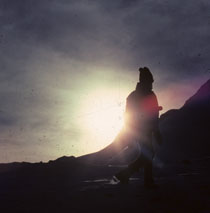Copyright & Revisions: Original copyright © 2002. Reformatted in 2013. No changes made to text.
Publication History: Originally published in the Proceedings of the 15th Annual International Conference of Outdoor Recreation and Education - ICORE 2001. Citation: Watters, R. (2002). An essay: The culture of safety. In Joyce, P. & Poff R. (Eds.), Proceedings of the 15th Annual International Conference of Outdoor Recreation and Education - ICORE 2001. (pp. 85-87). Bloomington, IL: Association of Outdoor Recreation and Education.
Reproduction Information: You are welcome to provide links to this page or to use short quotations and paraphrases in other documents as long as they appropriately reference the source. There is no charge for non-profit organizations to reproduce or publish extensive parts or all of this paper, but please obtain advanced permission from Ron Watters (wattron@isu.edu). Photo credits: Ron Watters.
Abstract
Any outdoor educator knows about rules. Outdoor educators spend a considerable amount of time dealing with them: risk management plans, accepted safety practices, and first aid protocols. But do rules really make programs safer? This essay looks at rules from an entirely different perspective, and suggests that true safety may lie in breaking the rules.
Sometimes Buddhists aren't the most practical people in the world. Take my friend, Harvey. He's a Buddhist. As long as I've known him, and long before it became a stylish thing to do, his head has been shaved. He teaches Yoga, has a peaceful countenance about him, and speaks slowly in measured tones. He is very spiritual, but very impractical, particularly when it comes to the outdoors. I doubt whether Harvey could find his way out of the woods on a well worn trail. His problem as I see it is rooted in his odd view of rules.
Rules. Any outdoor educator knows about rules. We, in the outdoor field, spend a considerable amount of time at conferences talking about them: risk management plans, accepted safety practices, and first aid protocols. You name it. We've got a rule. We know how to conduct ourselves: what we should or should not do, what our programs should or should not do, and what our participants ought and ought not do.
When you think about it, there's a considerable amount of hubris attached to all these rules. An unwritten dictum in the profession says that the number of rules one knows is directly proportional to status. It's like toys: the person who accumulates the most toys wins. The one who learns the most rules, rules. So what does Harvey say? Just this: Harvey says that you should learn the rules so you know how to break them properly.
Pshaw! Now isn't that the silliest thing you've ever heard? You can just hear the laughter and back slapping that would result if a Harvey were to show up and make such a remark at a national risk manager's conference. Break the rules? Why even have rules in the first place if you're going to break them?
Let's humor Harvey a bit more and take a look from his side of things. After all, looking at problems in more than one way is a rule in accident prevention.
When I told Harvey that the outdoor education field would find his view on rules absurd, he responded by asking me a question: Do rules really make our programs safer? Of course, I immediately answered. In fact, I explained, they've grown in importance. The more years I spend in outdoor education, the more rules I see. Risk management plans are swelling and operating procedure manuals run into dozens of pages. Entire books are published on accepted safety practices. The Association of Experiential Education has been known to charge nearly $100 for such books. Why, in fact, are some authorities in outdoor education pushing certification programs for outdoor leaders? Because certified people know the rules better! Any idiot knows that.
But Harvey responded in his very quiet manner and told me that no list of rules makes a program any safer. One must learn the rules, he said, but a person must go beyond the rules and build a storehouse of knowledge and experience in the sphere of activity that the rules cover. And then that person must gain even more experience and go so far beyond rules that they disappear and it's only their meaning that you are left with and breaking or keeping them no longer matters.
Can you imagine yourself repeating the above paragraph in an outdoor liability court case as an expert defense witness? The judge's eyes would roll and the plaintiff's attorney would be restraining himself from jumping up and shouting "thank you!"
But Harvey has touched on something that strikes a cord because the process of understanding is a step above rote memory. And when I asked him about how this is supposed to keep a program safer, he told me that an individual's true well being is not the product of rules but being the part of a culture of safety.
A culture of safety, he explained, is one in which everyone plays a part: managers, trip leaders and participants. It is not based on rules, but rather on the concept of participatory safety. It's a simple concept but powerful: members of the group watch out for one another. It's the entire group which helps keep the trip safe, not just one person.
That's very much different than the typical situation where there's one leader and he or she makes all the decisions, and is largely in charge of safety. Rather, Harvey says, an open environment should prevail on trips and activities. If someone sees something they are uncomfortable with, they should be free to express themselves, even members of the group with little or no experience. Everyone's opinions are valuable. Everyone helps make the trip safe.
When I thought about what Harvey said, it brought to mind a climb that I was on a number of years ago in the Tetons. While descending, I ran into a very well known mountain guide. He had been throughout the world, climbing some of the hardest routes imaginable and was immensely more experienced than I. As it turned out, he and I happened to end up as the last two people on a rappel. He was rappelling before me, but before he stepped over the edge, he asked me to double check the anchor, his harness, and rappel device. Then, in return, he took at look at my harness and rappel device.
That was it, and he was over the edge. It was quick, took no time, but it set the tone. It made me re-think and re-check my own rappel, and when I finished, it stayed with me, keeping me focussed on safety the rest of the way down the mountain. I was dumbfounded that this giant in the mountaineering world would even care about the opinion of someone with a fraction of his experience and knowledge.
He did care. Even well seasoned climbers can make mistakes and those of much lesser ability can point out possible problems. Nine times out of ten, there's no problem, but the one time there is a problem, it can save a life.
That's the sort of atmosphere that Harvey is suggesting and one that you want to cultivate in an outdoor program, one in which everyone helps watch out for one another. No matter what the ability level, no matter what the activity, all can help.
Participatory safety can become more contagious than the flu. When individuals with more experience ask for the opinions of others, they invite other members of the group to become owners of the trip or activity. Most often, it starts with your program's leaders, trip initiators and experienced participants, and it quickly leads to others, and then they spread it to more. I felt it on my climb in the Tetons, and that feeling that I was left with has been with me ever since.
After thinking about these things for a while, it dawned on me what Harvey meant by the culture of safety. It is something that becomes ingrained in you and your program. It truly makes programs safer like no set of rules on piece of paper can do.
But I'm not going to toss out the rule book yet. In fact, I'm heading back to my office right now to do a little more work on the risk management plan. I've got just one more rule to add: listen to Harvey more often.
[END]
|


